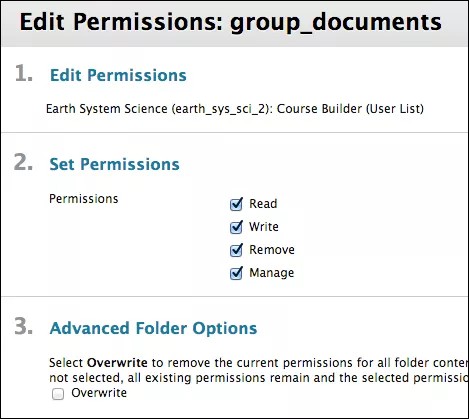This information applies only to the Original experience. Your institution controls which tools are available.
When you change the permissions for users, you decide who can view and perform actions on their files and folders available in Course Files.
By default, the roles of course builder, instructor, and teaching assistant (TA) receive read, write, remove, and manage permissions for files and folders uploaded directly to Course Files. Students don't receive any permissions for a file or folder until it is linked to content in a course. After you link the file or folder to content, it's assigned the read permission for all course users, which includes all users enrolled in your course. Students can view and download the linked file or folder.
You can change the permissions for any file or folder in Course Files. For example, to allow all teaching assistants to view and download, but prevent them from editing or deleting a particular file, change their permission to read permission.
Permissions
Permission describes a user's or a group's ability to interact with a file or folder in Course Files.
- Read means that the user can only see, open, and download the item.
- Write means that the user has read permissions, and can also edit or overwrite the item, including the file name and settings. If they have write permission for a folder, they can also create new items (folders and files) within it.
- Remove means that the user has read and write permissions, and can also delete the item.
- Manage means that the user has full control of the item and can grant permissions to other users.
To copy a file or folder, users need read permission for the file or folder (and all its files and sub-folders) and write permission for the destination folder.
To move a file or folder, users need read and remove permissions for the file or folder (and all its files and sub-folders) and write permission for the destination folder.
Edit user permissions
- In Course Files, navigate to the file or folder.
- In the file or folder's row, select the icon in the Permissions column.
- On the Manage Permissions page, open the menu for an item in the User/User List column and select Edit.
Delete removes the role and the permissions for the file or folder. To restore a deleted role, select Add Course User List. On the Add Course User List page, add or edit one or more roles and set the permissions for the file or folder.
- On the Edit Permissions page, select or clear the check box next to the Permissions type. For folders, select the Overwrite check box to make these permissions changes for all folder contents and sub-folders and replace all existing permissions. When you don't select Overwrite, the selected permissions are added to all folder contents and sub-folders, but previously existing permissions aren't removed.
- Select Submit.
- Select OK to return to Course Files.
Option to overwrite folder permissions
When you edit or add permissions to a parent folder, you have the option to force all files and sub-folders to inherit these permissions. For example, if the read and write permissions are added to the folder, all permissions would be reset to read and write. Any item within the folder that has other permissions, such as remove, would be reverted back to only read and write permissions.
If you don't select this option, the files and sub-folders are automatically granted any additional permission given to the parent folder, but existing permissions aren't deleted. For example, you add read, write, and manage permissions to a folder. An item within the folder already has read, write, and remove permissions. The permissions for the file would remain read, write and remove, and manage would be added.
After you edit permissions on a folder, you may edit the permissions on an item, but these will be overwritten the next time permissions on the parent folder are edited. This is one reason storing items with the same purpose and audience in a single folder makes managing permissions much easier.
About folder permissions
When files are uploaded or copied to folders, they inherit the same permissions as the parent folder. However, when a file is moved to a different folder, it maintains its original permissions. It doesn't inherit permissions associated with the parent folder. You can edit permissions after you upload, copy, or move files.
Keep in mind that editing a folder's permissions doesn't automatically overwrite the permissions for files contained in the folder. Instead, it adds to them. In the example below, an item in the folder had additional permissions. To make a file's permissions match the folder's permissions, use the Overwrite option on the Edit Permissions page.
Example: Your teaching assistant has read permission for a folder named Course Notes, and has read and write permissions for the Week 1 file within that folder. You edit the Course Notes folder permissions and add manage permission. Now your teaching assistant has read and manage permissions for the Course Notes folder and read, write, and manage permissions for the file.
If you select the Overwrite option, your teaching assistant has read and manage permissions for the folder and all files within it, including the Week 1 file.
You can edit an individual file's permissions, even after you use the Overwrite option for the entire folder.


